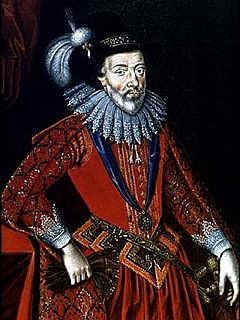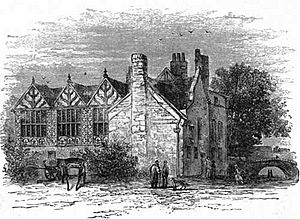William Stanley, 6th Earl of Derby facts for kids
Quick facts for kids
William Stanley
|
|
|---|---|
| Earl of Derby | |

William Stanley, the 6th Earl of Derby
|
|
| Known for | Travels, Shakespeare authorship candidate |
| Born | 1561 |
| Died | 29 September 1642 (aged 80–81) Chester, Kingdom of England |
| Nationality | English |
| Locality | Lancashire, Cheshire |
| Noble family | Stanley |
| Spouse(s) | |
| Issue More... |
|
| Father | Henry Stanley, 4th Earl of Derby |
| Mother | Lady Margaret Clifford |
William Stanley, 6th Earl of Derby (1561 – 29 September 1642) was an important English nobleman and politician. He was also a Knight of the Garter.
William inherited a powerful family position. His mother was even in line to become Queen Elizabeth I's successor. After his brother died, his niece Anne became the next in line to the throne.
William traveled a lot when he was young. Later, he had a long legal fight to secure his family's lands and titles. He chose to focus on managing his estates and supporting arts, including writing plays. Some people even believe he might have been the real author of William Shakespeare's plays.
Contents
Early Life and Family
William Stanley was born in 1561. His father was Henry Stanley, 4th Earl of Derby. His mother was Lady Margaret Clifford.
William's mother, Lady Margaret, was a very important person. From 1578 until she died in 1596, she was the person next in line to become Queen Elizabeth I. After Margaret died, her granddaughter Anne Stanley became the next in line. Anne was the daughter of William's older brother, Ferdinando.
Amazing Travels and Adventures
William Stanley studied at St John's College, Oxford. In 1582, he traveled to Europe to study in France. He might have even attended a special school run by Henry of Navarre.
In 1585, he returned home but was sent back to Paris as part of a special group visiting Henry III of France. He then stayed in Europe for three more years, traveling on his own. Some stories say that the famous writer John Donne might have traveled with him.
Stories of His Journeys
During his travels, William Stanley was said to have had many exciting adventures. People claimed he fought duels and had love affairs. He supposedly traveled through Italy dressed as a friar.
The stories also say he visited Egypt, where he fought and killed a tiger. Then he went to Anatolia (modern-day Turkey). There, he supposedly almost got executed for insulting the prophet Mohammed. The story claims he was saved because a Muslim noblewoman wanted to marry him. He turned her down and continued his journey.
He was said to have traveled to Moscow and then to Greenland. From Greenland, he supposedly returned to Europe on a whaling ship.
Are the Stories True?
These exciting stories come from a popular song called Sir William Stanley's Garland. This song made his three years of travel sound like "twenty-one years travels through most parts of the world." The song was written down in 1800 and published in 1801.
There are no official documents or records to prove these adventures actually happened. However, these stories were often repeated in books about William Stanley in the 1800s.
Inheriting Titles and Lands
| Hypothetical succession in the female line from Henry VII, through his daughter Mary and her second marriage |
|||||||||||||||||||||||||||||||||||||||||||||||||||||||||||||||||||||||||||||||||||||||||||||||||||||||||||||||||||||||||||||||||||||||||||||||||||||||||||||||||||||||||||||||||||||||||||||||||||||||||||||||||||||||||||||||||||||||||||||||||||||||||||||||||||||||||||||||||||||||||||||||||||||||||||||||||||||||||||||||||||||||||||||||||||||||||||||||||||||||||||||||||||||||||||||||||||||||||||||||||||||||||||||||||||||||||||||||||||||||||||||||||||||||||||||||||||||||||||||||||||||||||||||||||||||||||||||||||||||||||||||||||||||||||||||||||||||||||||||||||
|
|||||||||||||||||||||||||||||||||||||||||||||||||||||||||||||||||||||||||||||||||||||||||||||||||||||||||||||||||||||||||||||||||||||||||||||||||||||||||||||||||||||||||||||||||||||||||||||||||||||||||||||||||||||||||||||||||||||||||||||||||||||||||||||||||||||||||||||||||||||||||||||||||||||||||||||||||||||||||||||||||||||||||||||||||||||||||||||||||||||||||||||||||||||||||||||||||||||||||||||||||||||||||||||||||||||||||||||||||||||||||||||||||||||||||||||||||||||||||||||||||||||||||||||||||||||||||||||||||||||||||||||||||||||||||||||||||||||||||||||||||
When William's father died in 1593, William received several lands and properties. His older brother, Ferdinando Stanley, 5th Earl of Derby, inherited the main family title and estates.
However, Ferdinando died just a few months later in April 1594. He had three daughters but no sons. Ferdinando's daughters claimed their father's estates. William, as the next male heir, inherited the titles of Earl of Derby and Baron Strange.
A Complex Legal Battle
Things became even more complicated when Ferdinando's oldest daughter, Anne Stanley, Countess of Castlehaven, became the official heir to Queen Elizabeth's throne in 1596. This led to a long and difficult legal dispute that lasted for many years.
During this dispute, the Isle of Man, which belonged to the 5th Earl, was taken by the Queen. But the Queen gave it back to the Stanley family because of their loyal service. William was granted important lands in Lancashire, Cumberland, Yorkshire, Cheshire, and Wales.
Ferdinando's daughters received other estates and the Isle of Man. However, they later sold the Isle of Man to their uncle, William. King James I later confirmed William's right to the island. William kept the title of Lord of Mann but let his niece, Anne Stanley, manage the Isle of Man. In 1612, he gave the title to his wife, Elizabeth.
William's claim to the title of Baron Strange was not questioned during his lifetime. But after he died, it was found to be incorrect. A new Baron Strange title was then given to his son.
His Career and Later Life
The Stanley family was related to the royal family through King Henry VIII's sister, Mary Tudor. Because of this, they were sometimes suspected of having sympathies for the Roman Catholic faith.
There were many rumors about the sudden death of William's brother, Ferdinando. Ferdinando had been asked to join a plot against Queen Elizabeth but had stayed loyal to her. Because he died so suddenly, many people thought he had been poisoned.
Queen Elizabeth did not allow William to join the Earl of Essex's military campaign in Ireland. This might have been because of fears that the Stanley family could lead a rebellion with Irish Catholics.
So, William chose to stay out of national politics. He focused mainly on managing his family's lands and his important role in local government in Lancashire and Cheshire. In 1603, he became a member of the Privy Council of England, a group of advisors to the King.
Queen Elizabeth gave William the Order of the Garter in 1601. King James VI and I appointed him Lord Chamberlain of Chester.
A few years after his wife died, William was "old and weak." He wanted to retire from his busy life. He gave his estates to his son James, keeping an annual income of £1,000. He bought a house near the River Dee outside Chester. He lived there quietly until he died on 29 September 1642.
The Shakespeare Authorship Question
William Stanley is one of several people who some believe might have been the real author of William Shakespeare's plays. This idea is part of the Shakespearean authorship question.
Why Some Think He Wrote Shakespeare's Plays
The idea that William Stanley wrote Shakespeare's plays was first suggested in 1891. An archivist named James H. Greenstreet found letters from a spy named George Fenner. In 1599, Fenner wrote that William Stanley was "busy penning plays for the common players." This means he was writing plays for actors.
Greenstreet believed that some funny scenes in Shakespeare's play Love's Labour's Lost were inspired by a local show in William Stanley's hometown of Chester. Greenstreet died before he could fully explain his ideas.
The theory was brought up again in 1915 by an American writer named Robert Frazer. He concluded that "William Stanley was William Shakespeare." Later, a French expert named Abel Lefranc published a detailed book supporting the idea in 1918. Several other authors have also supported William Stanley as a possible author, sometimes suggesting he was part of a group of writers.
Other Ideas
Leo Daugherty, who wrote about William Stanley for the Oxford Dictionary of National Biography, believes Shakespeare himself wrote the plays. However, Daugherty has suggested that William Stanley might be the "Fair Youth" mentioned in Shakespeare's sonnets. He also thinks that Richard Barnfield is the "Rival Poet" in the sonnets. William Stanley was a supporter of Barnfield, and Barnfield wrote a series of poems about him called The Affectionate Shepherd.
Family Life
On 26 January 1595, William Stanley married Elizabeth de Vere. Elizabeth was the daughter of Edward de Vere, 17th Earl of Oxford. Her mother was Anne Cecil.
Some people believe that William Shakespeare's play A Midsummer Night's Dream was inspired by their wedding. It is even thought that the play might have been performed for the first time at their wedding celebrations.
In the early years, their marriage was a bit difficult. But as William's financial and social position became more stable, their relationship improved. William and Elizabeth had five children:
- James Stanley, 7th Earl of Derby (born 1607 – died 1651).
- Robert Stanley (died 1632).
- Anne Stanley, Countess of Ancram (died 1657). She married Sir Henry Portman first, and then Robert Carr, 1st Earl of Ancram.
- Elizabeth Stanley. She died young.
- Elizabeth Stanley. Named after her older sister who had died. She also died young.




